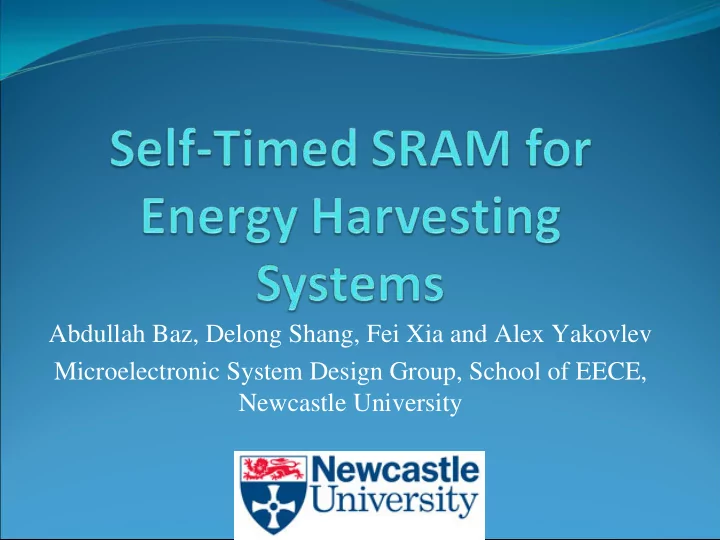

Abdullah Baz, Delong Shang, Fei Xia and Alex Yakovlev Microelectronic System Design Group, School of EECE, Newcastle University
Agenda � Introduction � Research motivation � Methodology � Proposed solution � Analysis and Results � Conclusion � Future work
Pass transistors Introduction
SRAM operation � Reading: � Precharge bitlines � Open WL � one bitline will be discharged � Writing: � Precharge bitlines � Enable write driver � pull down one of the bitline � Open WL � new data will be written
SRAM timing � SRAM works based on timing assumptions to ensure safe reading and correct writing � The timing control block controls the time for precharging, opening the WL, enabling the write driver � Timing control methods: � Clock � Delay line (inverters chain) � Replica bitline (dummy column)
Previous work � SI for reading and delay line for writing [A four phase handshaking asynchronous static RAM design for selftimed systems by Vincent Wing-Yun Sit et al .] � SI for reading and delay line for writing based on timing assumption (vdd ranges from 0.7V to 1.5V) [GHz asynchronous SRAM in 65nm by J. Dama and A. Lines] � New cell with 13T [Design and verification of a self-timed RAM by L.S. Nielsen and J. Staunstrup]
Previous work (SI reading)
Previous work � SI for reading and delay line for writing [A four phase handshaking asynchronous static RAM design for selftimed systems by Vincent Wing-Yun Sit et al .] � SI for reading and delay line for writing based on timing assumption (vdd ranges from 0.7V to 1.5V) [GHz asynchronous SRAM in 65nm by J. Dama and A. Lines] � New cell with 13T [Design and verification of a self-timed RAM by L.S. Nielsen and J. Staunstrup]
Behaviour of SRAM under variable Vdd � Investigate the latency mismatch between the SRAM and the inverter-chain under different Vdds
Investigation results
SRAM timing variations � The timing variations of SRAM can be caused by: � Nondeterministic supply voltage (energy harvesting) � Process Voltage Temperature (PVT) variations � Effect of timing variations: � Read failure: open WL before deactivation precharge � Access failure: close WL before discharge one of the bitlines � Write failure: close WL before data is written
Methodology � Asynchronous design regulates the data flow of the circuit based on the actual speed of the circuit � The handshaking protocol tracks any latency variations � Self-timed design with completion detection can adapt with Vdds
Our contribution � Prove that typical delay line can not track (without penalty) SRAM timing variation under highly variable supply voltage � Design a novel asynchronous fully SI SRAM memory based on the 6T cell (no need to increase number of the transistor or change the architecture) � Demonstrate the ability of our memory to work under wide range of variable supply voltage � Propose new method to build delay elements for bundled SRAM memory
1 1 0 0 Proposed solution
Proposed asynchronous controller
Operation: initial state
Operation: writing
Operation: writing
Operation: writing
Operation: writing
Operation: writing
Operation: writing
Operation: writing
Operation: writing
Operation: writing
Operation: reading
Operation: reading
Operation: reading
Operation: reading
Operation: reading
Operation: reading
Operation: reading
Proposed solution under variable Vdd
1 Kbit (64x16) fully SI SRAM (6T)
1 Kbit (64x16) fully SI SRAM (6T)
Conclusion � Under non-deterministic supply voltage, the first concern is the timing variations � Typical delay line is not suitable to track the timing variations in SRAM � Asynchronous design can solve this problem at the expense of area and energy
Future work � Find out an accurate model for the harvester to test our proposed SRAM � Find out the overhead of the proposed solution in terms of area and performance � Analyze the proposed controller under the process variations � Fabricate the design to demonstrate its functionally
Question
Recommend
More recommend